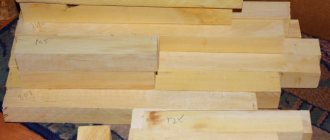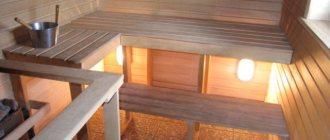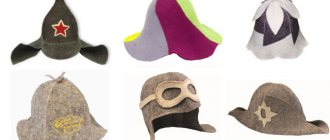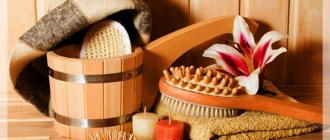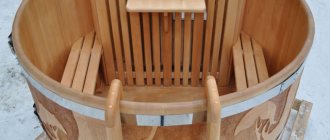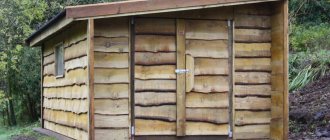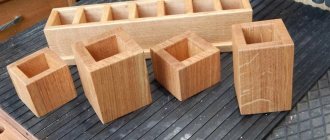The Russian bathhouse is loved and respected by the people. It’s not for nothing that they say about her: “The bathhouse is the second mother: she will steam the bones and straighten the body.” Because a bathhouse is not just a “washing room”; it is customary to take a steam bath in it, to drive away illnesses and blues. It’s rare that a country house can do without a traditional Russian bathhouse. They build it and equip it with special love and care. They think through down to the smallest detail heating, water and steam supply, design and finishing of all rooms. But an important place in the equipment of a bathhouse is occupied by bath accessories. This article is about what bath utensils every self-respecting bathhouse owner should have.
When you think of bath accessories, the first thing that comes to mind is a broom. So what is it like, and how to choose it correctly?
Purpose of cooperage products
- A tub is a small “bucket” made of wood, equipped with two small handles - “ears” (hence the name). It is customary to store cool water in such a container for rinsing after a steam room. In addition, a hanging bath tub can be used for steaming brooms (in the absence of a steamer)
- A wooden or copper ladle is perhaps the most necessary container for a steam room. Its main purpose is to “water” the stones with water to produce a large amount of steam. In addition, you can use the ladle to rinse off after the procedure.
- Shayka is a small wooden basin that can be used both for washing and steaming brooms. If you want to get maximum pleasure from visiting the steam room, you should buy a sauna bowl made of natural wood - the plastic basins that replace the steam baths are not able to maintain the “correct” water temperature and do not fit the overall interior of the steam room.
- A steamer is a highly specialized container designed for steaming brooms. In warm water, brooms become soft, which is extremely important when using them. In addition, brooms lying in the steamer begin to spread a pleasant birch aroma throughout the steam room.
Tub
A large tub with protruding “ears” with holes at the edges. Sticks were inserted into them when the tub needed to be dragged from one place to another. As a rule, a tub was used to store or transport water. Two people carried it, since it was not always possible for one person to lift the tub.
Lohan
This is a large, roomy vessel, which was intended for various household needs. The housewife used the tubs for washing dishes or washing clothes.
These containers were made of metal or wood. The shape was different, as was the volume. There were tubs with legs and special stands, which made them very convenient to use.
Accessories for baths and saunas - all the subtleties of choice
Today, a rack with bath accessories can be found in any home goods supermarket. And if you look into a specialized store, you can simply get lost in the assortment of accessories for baths and saunas! Bowls and tubs, containers for steaming brooms and the brooms themselves made of different materials, humidifiers and air flavors, thermometers, funny felt hats... How can you choose from this variety those things that will really be useful to you and will make visiting the steam room convenient? Let's try to figure it out.
- Bathhouse according to all the rules Wood
- Plastic
- Metal
- Gang
History of the tub
A tub is a container for carrying water and storing food. “The whole forest is short, but two trees are taller than all of them” - this is how an old folk riddle figuratively conveys the design features of this cooper’s vessel. Another riddle hints at the origin of its name: “The carcass has ears, but no head,” thanks to the ears, which are two rivets with holes protruding above the side walls. Ears have a dual purpose. Firstly, with their help you can tightly close the tub, and secondly, if necessary, move it to another place.
During excavations in ancient Novgorod, scientists were able to discover individual parts of tubs made in the 13th-14th centuries. The reconstruction, carried out based on the found fragments, made it possible to imagine what this cooper's vessel looked like, used by the Novgorodians mainly for carrying and storing water. The rivets from which it was assembled were rectangular, and therefore the tub itself had a cylindrical shape, which turned out to be quite stable.
Tubs similar to those from Novgorod are depicted in the popular print “How Mice Buried a Cat,” made at the beginning of the 18th century. Since the cat has always been the enemy and oppressor of mice, he was buried with the greatest rejoicing. Of course, such a celebration could not exist in the folk artist’s imagination without music - and he painted a mouse playing the bagpipes, without a snack - a mouse was drawn with a full box of pies on his shoulders and, of course, without “good drink”, that is, mead or beer. And so that there is no doubt, they wrote at the top: “The mice bring a tub of good drink...”
The depicted tub not only has an ancient shape, but the method of carrying it remains equally ancient. That is, they put a pole through his ears, put its ends on his shoulders and carried it together. Unlike a bucket, a tub is designed to carry water only for two people, which is why it holds much more water than a standard bucket. The heavier the tub of water was, the more difficult it was to lift it onto the shoulders. Gradually, a device with which a tub could be carried without lifting it high above the ground began to come into use. A short chain called a hitch was attached to the pole in the middle. The free end of the hook was connected in the middle to a shorter pole. When carrying a tub, a short pole was inserted into its ears, and a long one was placed on the shoulders. Thus, when carried, the tub hung on a hook at a short distance from the ground.
In different parts of Russia, this simple device was called differently: khlud, yoke, water-carrier, club, dryuk, oslop and banner. Its wooden parts were made from durable birch or oak wood, because they had to withstand quite a large load, especially if it was necessary to carry tubs that could hold several buckets of water. To avoid splinters on the hands, the poles (especially the large one, which was placed on the shoulders) were carefully polished. And they polished them involuntarily with the palms of their hands. The more the tub was used, the more intense the shine the wooden parts of the tub acquired. To carry a full tub of water over a considerable distance without spilling it, you had to have a certain skill. And only a leak in the tub could justify the water carriers who failed to bring a full tub of water. As the popular saying goes: “Things are not bad, but mornings are thieves.”
Water in tubs was carried from a well or river not only home, but also to the meadow during mowing time and to the field during the time of need. They also carried water for watering garden beds. The tub was especially indispensable where water could not be delivered on a water barrel, since instead of a road there was only a narrow path underfoot.
Nowadays, tubs have not become obsolete, but they are most often used for salting lard and meat. In the old days, tubs for salting meat, lard, and fish were made from birch and aspen; in such a vessel, the taste, smell, and color of the products did not change. For ease of storing food, it was made with a body extended at the top. Meat, lard, and fish placed in the tub were pressed tightly with a lid that had a wooden bar-bar, the ends of which were inserted into the holes of the “ears.” Tubs, like other cooperage and dugout utensils, have been common in Russia since very ancient times.
In the last century, craftsmen also made small tubs intended for storing melted butter or, as it was also called, Russian butter. Small earflaps of two or three liters, hollowed out of a tree trunk, were widespread. In the dugout cylinder, ears were cut out on one side, and the bottom was inserted on the other. A wedge-shaped rod was inserted into the eyes (the same as in a tub for salting meat), which pressed the roof of the tub. There were hollowed-out shells, the lids of which were locked using special iron brackets.
In those areas where the cooperage craft was developed, they soon abandoned labor-intensive dugout utensils: utensils for butter began to be made on a cooper's basis. In the Arkhangelsk province, ushats for storing melted butter were called skobkars. Vladimir Ivanovich Dal writes in the Explanatory Dictionary that “a stapler (arch.) is a tub for oil with two eyes in rivets, for a bolt and with a lid.” It was noted that in wooden dishes (and especially in linden) oil does not go bitter for a long time and ceramic, porcelain, and even modern enamel dishes cannot be compared with wooden ones. It is known that when butter or margarine is stored in a transparent container, the upper layers become greasy under the influence of light: an unpleasant greasy odor appears. In closed wooden dishes this process is eliminated. Moreover, the wood can be impregnated with substances that promote long-term storage of such products. The easiest way is to soak it in a strong salt solution. Hot salted water is poured into a cooper's vessel (in this case, a bowl) and kept in it until it cools down. After draining the water, the vessel is dried and only after that butter or margarine is loaded into it. At temperatures from 0° to 4°C, products retain their freshness for about two months. The utensils are in the same natural connection with the oil as the shell is with the kernel of a nut. Therefore, in such a container, oil can be stored for a long time not only in the refrigerator or cellar, but also in any cool place.
In modern conditions, the urinal scraper can be successfully used not only for storing oil. If you attach a convenient handle to the lid, you can take it into the forest to pick berries. Raspberries, strawberries, blueberries, cloudberries and princesses feel much better in wooden dishes than in metal or glass, not to mention plastic. The berries do not wrinkle and do not spoil for a long time due to the fact that wood is an excellent insulating material. This is what prevents the contents of the bracket from overheating in the sun. The dimensions of the bracket designed for storing oil can be very different: it all depends on the economic need.
What is it for?
The gang looks very much like an ordinary bucket. The only difference is the dimensions. So, the bath accessory is lower, but wider than a simple bucket. There are handles on the sides, one or two. The design allows you to carry hot water without the risk of getting burned.
The gang is used for different purposes. You can use it to steam brooms. You can pour hot water from the container.
Also, various herbs are often steamed in a basin and oils are mixed.
About the bath tub in more detail
The tub is one of the most ancient types of dishes; it was used in Rus', in the 13th century. Such products, as a rule, were made from birch, oak or other species of deciduous trees. The most popular tree for the production of antique tubs was oak.
Today, good tubs are made from the same types of wood. The peculiarity of production is that they are produced without the use of varnish and glue, without adding any foreign synthetic materials. This means that these devices are truly natural. For a more reliable fastening, a metal hoop , which is not afraid of corrosion even in conditions of high humidity.
Such a container is needed for a bathhouse, because it allows you to completely immerse yourself in this atmosphere. Wood products are pleasant and useful to use because they transmit heat and have an incredibly subtle scent.
Difference from gang and tub
Those who love baths usually try to follow the traditions and order of the procedure. But for the best effect and greater benefit from bath procedures, it is worth choosing and using all the accessories for the steam room correctly.
For example, few people know the difference between a gang and a tub. Indeed, they are similar, but there are still key differences.
The gang is less capacious; it is always made in a horizontal form. It can have one or two handles and can be used without a lid.
Like the tub, the gang is made of wood. The most commonly used wood is larch or cedar . The direct purpose of this container is to steam herbs or dilute oil. While steaming in the sauna, the contents of the gang are poured over the hot stones or walls in the steam room.
The tub is made of wood, but its main differences are low sides and a wide round or oval bottom. The handles are located on the sides and have through holes. They were made this way for a reason: a stick was inserted into these holes, and the tub could be carried by one person at the moment when it was filled with water.
Bath accessories: nice little things
Aromatic oils, scrubs, nourishing masks, herbal infusions are not a necessary attribute of a bath. But they make your stay even more enjoyable, creating a special atmosphere and comfort. As well as all kinds of interior accessories: signs and signs.
A bathhouse equipped with the necessary utensils will bring indescribable pleasure and drive away illnesses. Because it’s not for nothing that people say: “The bathhouse soars, the bathhouse rules, the bathhouse will fix everything.”
Varieties
Tubs, like any other accessories, differ in the material used in their manufacture. Most often used:
- oak;
- cedar;
- larch;
- linden
copper have recently become very popular , but in most cases their volume is small. All-steel models can also be found on sale. The rim of wooden products is made of high-quality stainless steel. On some tubs, the steel is not only on the outside, but also on the inside (in the form of an insert). It protects the wood from direct contact with water, thereby increasing the service life of the product.
You want to go to the bathhouse at any time of the year, but diving into a cold body of water or snow after steaming is not always possible. Especially in urban environments. In this case, a hanging tub is a real salvation. It is compactly hung on the wall using a specially designed rope, turning out to be a relevant thing in small spaces.
The tub sizes vary from 3 liters to 35 liters.
Smaller ones are often made with one handle and can be used alone. Medium-sized tubs are made in a classic style and have two handles.
Large tubs have rope handles or are made with special wall mounts. They are mainly used as a contrast shower.
Tips for choosing
The gang is of great importance in the bathhouse. The comfort of the entire procedure largely depends on it. Therefore, it is important to consider certain criteria when choosing.
- Number of users. In general, it is recommended to purchase individual gangs with a small volume. So, products for 4 liters or 6 liters will be just right. If you definitely need one container for everyone, then you should give preference to 25 liter models.
- Wooden products are very capricious. It is important to store them exclusively in a dry place, away from a heat source. It is worth considering a special room in advance or completely abandoning the purchase of a wooden gang. An alternative would be a metal product. It is less demanding.
- Application options . The shaker is used for more than just pouring water. With great comfort, you can steam brooms and prepare herbal infusions in the container. Some plants have pungent odors. So, you should purchase small wooden or plastic containers for each set of herbs.
- Ergonomics of handles. Convenience is of great importance, especially with large volumes. The handles must match the size of the gang. It is important to ensure the appropriate size and quality of fastening.
Usage
Modern bath utensils are made of high-quality material. Metal elements are made of stainless steel. If the inserts are plastic, then they are not designed for too high temperatures.
If you rarely visit the bathhouse, then tubs made of combined materials (for example, wood and steel) are best suited. The fact is that completely wooden containers, when left idle without water, tend to dry out and may begin to leak. Even so, they can be revived by soaking them in water and allowing them to swell.
Modern tubs can be used for different purposes : water is poured into them for irrigation on stones, brooms are steamed, aromatic herbs and oils are diluted. When purchasing a tub, it is important to remember several rules that will make it last longer:
- before the first use, you need to pour cold water into the tub, and then leave the item for 2-3 hours;
- After use, you should rinse the tub with hot and then cold water.
stored in a cool room with little light. They should not be exposed to dry in direct sunlight or near heating devices . In such cases, the wood will simply dry out, and the containers will lose their shape or even fall apart. The tub should be stored upside down . This is necessary so that it is ventilated. Periodically, the container needs to be checked for integrity , to see if the metal rings are coming apart. If the rings are loose, they can be tightened.
It is important to maintain hygiene and clean the tubs regularly.
Products that are free from chemicals and odor should be used. This is one of the main rules, otherwise the next time you go to the bathhouse, when you want to dilute aromatic herbs or oil bath brooms, they will begin to smell like chemicals, which will be more noticeable at high temperatures.
Main characteristics
Material
Wooden tubs are not only pleasant to use - they transmit the smell and warmth of wood. This turns a visit to a Russian bath or Finnish sauna into a real ritual. The containers are made from linden, pine, cedar, oak, and aspen. The most popular are cedar and linden. Oak tubs are more durable, but they are also more expensive. The products are not glued or varnished, so they are safe and do not emit toxic substances. Often the surface is treated with a special waterproof solution.
Galvanized tanks are a budget replacement for a wooden tub. Used to store water for various needs.
Insert
The container may have an insert made of plastic, metal or enamel inside. It protects the wood from moisture and high temperature, thereby increasing the service life of the tub.
Size
Classic tubs have a small volume of up to 5 liters. They are suitable for diluting herbal mixtures or washing with cold water. And for steaming brooms or dousing, you will need deeper ones - up to 30 liters. Depending on your needs, select a tub for a bath and sauna of the right size.
Recommendations for use
- Before first use, pour cold water into the container and leave for a couple of hours. Then rinse the tub with hot and cold water alternately.
- Wipe it dry after use.
- When storing, avoid sudden temperature changes.
- To clean the tub, use baking soda.
Connoisseurs of baths and saunas always have the necessary utensils in the steam room. Choose a tub on our website for your bath procedures.
Broom
Of course, a broom is the main attribute in a bathhouse. There is even a saying: A bath broom is older than the Tsar, if the Tsar takes a steam bath!
A broom is, by and large, a special medical instrument. Because it is capable of providing a powerful massage effect, improving blood circulation, increasing blood flow, and saturating the air with aromas. As a result, metabolism accelerates. And in the complex there is a healing and rejuvenating effect.
What are bath brooms made from?
Bath accessories: brooms made from deciduous tree branches
Brooms for the steam room are prepared from branches of deciduous trees: birch, linden, oak, rowan.
Birch broom
Traditional healers consider a broom made from flexible birch branches with elastic leaves to be the best. Because thanks to the aromas inhaled with steam and superficial massage, birch cleanses the skin pores. Broom leaves, when massaged, remove sweat and toxins from the skin. But it is known that the healing of the body begins with its cleansing.
The preparation of branches is usually done 10-15 days after the Trinity Day. At this time, the plant buds contain the maximum amount of flavonoids, resins, and essential oils. Young, recently blossoming leaves are rich in ascorbic and betulorethic acids, phytoncides and saponins. It is these substances that have a healing effect.
Oak broom
An oak broom is a classic bath attribute, especially recommended for oily skin. Because, thanks to the tannins, quercetin, and essential oils contained in the leaves, it helps cleanse the skin, restore its elasticity, and relieve inflammation. The esters released when the broom is steamed have a hypertensive effect.
Young elastic branches with young, medium-sized bright green leaves are prepared for the broom. It is better to take the lower branches, which receive the least amount of sunlight.
Brooms from other hardwoods
Linden brooms are prepared for the steam room. The aroma of linden has a calming effect, banishes insomnia and depression. The feeling of anxiety is relieved and the airways are cleared.
Eucalyptus brooms are less common, because the tree is southern. Eucalyptus leaves contain more than three percent essential oils, which, when inhaled, have a beneficial effect on the cardiovascular system and respiratory system. A properly prepared eucalyptus broom should have bright green leaves.
True experts add several stems of fragrant medicinal herbs to their bath brooms: wormwood, sage, chamomile, oregano, mint.
Coniferous brooms
Bath lovers highly value soft and fragrant fir brooms. Juniper trees are harsh and quite prickly, so only particularly persistent vapers use them.
You can find bamboo whisks in stores. Which can be used for light massage. But, to be honest, it is inferior to a traditional broom: there is no aroma.
Cooperage craft
Just a century ago, wooden utensils and accessories were widespread. First, all the utensils, including the tubs, were hollowed out from a tree trunk: the insides were taken out of it and a cylinder was obtained. The bottom was attached to the bottom, and ears were cut out from the top, thanks to which, in fact, this vessel got its name. A rope was threaded through these ears, serving as handles for carrying the tub, or a rod holding the lid.
Gradually, the cooperage craft developed and, from a certain time, wooden utensils began to be made from special staves or frets. When you look at barrels, tubs, fonts, buckets, your soul becomes joyful and warm; they have an ideal shape, which craftsmen have honed over many centuries.
Staves can be sawn or chipped, the latter being more durable. Their production requires the cooper to have a sense of wood and great skill, as they must be clean and even. Therefore, do-it-yourself bath tub
can only be done by someone who knows and has studied cooperage well. Craftsmen have long noticed that raw wood splits better. Therefore, in the old days, rivets were prepared directly in the forest, at the site where trees were felled. The prepared frets should be thoroughly air-dried in a ventilated place for three months. Previously, drying was accelerated using a Russian oven - the ends of the staves were sealed with paper using wood glue and placed in a well-heated oven. Within a day they could be used to make barrels or other utensils.
The staves are tightened with wooden hoops - from lilac shoots, bird cherry or spruce branches; elm, oak, hazel, and maple are also suitable. For small cooperage projects, hoops are made from linden bark. To make the product more durable, hoops are made of metal, but this is used with great caution, since iron leaves unaesthetic rusty marks on the wood.
In cooperage, as in any craft, there are many secrets and subtleties that need to be carefully studied in order for the results of the work to be successful. The nuances of making wooden products are passed on to next generations, and now in Russia the demand for it is quite high.
DIY bath tub
The tub is the most ancient type of utensil. These products are usually made from aspen, oak, birch and other deciduous trees. Tubs have been used in Ancient Rus' since the thirteenth century. During excavations at the site of Ancient Novgorod, the remains of rivets were found, from which it was possible to recreate the container used in those days. It turned out that they had a cylindrical shape, were stable, comfortable and were used for carrying water, storing wine or oil, and so on. In Russian art and literature, the tub symbolizes celebration and feasting. There is a well-known popular print “How mice buried a cat.” It dates from the seventeenth century and depicts mice rejoicing at the funeral of their main enemy, the cat. One carries a box of pies, another plays the bagpipes, and everyone else holds tubs of beer and mead. The inscription under the picture reads: “The mice bring a tub of good drink.” It can be noted that since those ancient times, the appearance of this dish has remained unchanged, only now it is used not for drinking, but as a bath accessory. Also used in bathhouses are the ancient steamer and shishka containers. Water is carried and stored in a tub, herbal infusions are made in a bowl and flavorings are diluted, and brooms are naturally steamed in a steamer.
The peculiarity of the tubs is their ears, formed by two longer rivets located opposite each other. The walls of these products are inclined inward, which allows less water to splash than in dishes with straight walls.
For a cooper who is good at making barrels, it is easier to make a tub, since in this case there is either no need to bend the rivets at all, or just a little bit. But in any case, the work begins with a drawing, according to which the shape and the required number of rivets are determined. Then templates are made for them, blanks and a bottom are made from them.
Using bags with herbs in the bath
Depending on the equipment of the bathhouse, the use of steaming differs.
So, if the room has a heater, then the prepared herbal infusion should be watered in small portions, after wetting it at least twice with clean water. In this case, precautions must be taken due to the possible excess concentration of essential oils in the steam. Their effect on each person is different, therefore, in order to avoid poor health, it is recommended to use minimal dosages with consistent increases.
If a steam generator is used in a sauna or bathhouse, then to saturate the steam with an infusion of medicinal herbs, it is sprayed on the walls and shelves.
Many consumers of such products have a natural question: why can’t they use herbs without bags or sachets?
The answer is quite simple. When watering with an infusion with possible inclusions of wheatear grass, its remains may settle on it and subsequently emit a burning smell. At the same time, using a steaming bag has some advantages. After preparing the infusion, it is recommended to apply it to parts of the body as a medicine or cosmetic. Article on the topic: How to properly pour a foundation for a fence
Rules of care
The scope of use of wooden utensils narrowed along with the widespread use of ceramic and porcelain utensils. However, although they are good and practical, ceramics and porcelain are not suitable for all cases. Thus, a bathhouse and a sauna, at any time, are unthinkable without wooden utensils and special bath accessories , and using ceramic, porcelain or metal utensils in a bathhouse is extremely impractical, and this violates established bathhouse traditions.
It should be borne in mind that containers made of wood require special care, operation and storage. The fact is that wood is extremely sensitive to changes in humidity, and it tends to dry out over time. If you notice that such an inevitability has occurred, then the dishes need to be filled with cool water. So it needs to be allowed to stand for some time so that it is saturated with moisture. Then pour out the cold water and pour boiling water over the cooperage product. This will help him return to his previous form. Also, we must not forget to thoroughly rinse cooperage products after each use and scald them with boiling water.
Please note that when interacting with various foreign substances, wooden products can often change color. This is completely normal and does not affect their performance properties in any way. To prevent tubs and other wooden products from drying out, they are stored away from sunlight. It is best to leave them on the floor, on the bottom shelf in the steam room or in any room without windows.
If you strictly follow all the simple rules described above, then your bath accessories will last as long as they once served our ancestors.
Bath accessories: personal hygiene items
In a steam room, it is important to observe the rules of personal hygiene; the necessary attributes for this are rugs and ladders.
Steam room rugs are laid out on heated benches or shelves to protect against burns. They are made from felt or sheep's wool. Such rugs are individual bath accessories.
Sauna ladders are wooden gratings made from linden or alder planks. First of all, they save your feet from sliding on the floor and injuries, as well as from burns or overheating.
How to choose a bathhouse
Everyone who has a bathhouse or likes to visit it knows perfectly well that a pleasant time in a bathhouse cannot be complete without a variety of gadgets and accessories, such as: a bucket; scoop; gangs; special mug. If there can be no problems with choosing a bucket and mug, then to choose a gang, you need to know a few basic rules. This article will talk about how to choose a bathhouse, when it appeared, and what material it is made from. And, also many other interesting facts about this accessory.
What does “gang” mean and what is the purpose of this utensil?
To begin with, it is necessary to determine the meaning of the accessory; a gang is a special basin for a bath, which has a low height and handles. It is made exclusively from wood, by gluing wooden elements and processing paint and varnish material. In most cases, the bowl is made by hand and independently, but if there is no opportunity or skills to create wooden utensils, then you need to know how to choose a bathhouse.
In order to understand the basic rules of choice, as well as the features of this utensil, you must remember that this mandatory accessory has a long history. The gang was invented back in ancient Rus', when baths appeared. During the period of its existence, the gang changed. Therefore, there are different models of this accessory, there are gangs of large and small sizes, with two handles, as well as with one. It should be noted that during archaeological excavations on the territory of the city of Novgorod, it was found that earlier in this territory, while spending time in the bathhouse, our ancestors used small gangs with one handle. In addition, it was established that these bath utensils began to be produced for mass use in the twelfth century.
Since that long ago, the gang has not changed much, at least its key features. Since it was established that the ancient gangs, like modern gangs, the handles of the ancient gangs were slightly rounded so that the palms would not be cut. In addition, the handles also had small holes with which they could be hung on the wall in the bathhouse. For ancient ancestors and modern bathhouse lovers, the capacity of the gang was also important when choosing. As before, the buckets, depending on their size, can mix from 5 to 25 liters. To answer the question, how to choose a bathhouse? You should take into account the dimensions of the bathhouse, as well as the number of people who are steaming at the same time. If there are 1-2 people in the steam room, then a 5-liter bottle is quite enough, but if there are more, then you should purchase a more spacious bottle.
What should you pay attention to when choosing?
When selecting and purchasing a gang, the material should also be taken into account. Of course, the gang is made exclusively from wood, but what kind? In most cases, this bath attribute is made from wood such as linden. The advantages of this material are that bath utensils made from linden are very light and comfortable to use. In addition, utensils made of this material on the wall of the bathhouse complement the atmosphere of the bathhouse with their aroma. The only drawback is the cost of the linden gang.
Thus, it can be argued that for a small bathhouse that has a small capacity, it is recommended to purchase a small 5-liter bowl with one handle. If the bath will involve more than two people, then it is recommended to purchase bath utensils with two handles and a larger volume. As for the material, for a more pleasant time in the bathhouse it is better to purchase utensils that are made of linden.
Bath utensils and accessories
The main bath utensils are various containers with different volumes, each having its own precisely defined purpose.
As a rule, the classic version involves making them exclusively from wood, most often from linden, but modern bath interiors are decorated with steel, copper, and other objects. Article on the topic: How to build a house from turnkey timber yourself inexpensively
Wooden utensils are made exclusively using a glueless, cooperage method; they are environmentally friendly and very organic in a bathhouse interior. Often the choice of modern products is explained by a purely practical purpose - unlike wood, they do not require pre-soaking before visiting the bathhouse and do not dry out if they have not been used for some time.
Ensuring safety in the bathhouse
Bath equipment.
The bathhouse must be equipped with instruments for measuring temperature and air humidity; thermometers are even recommended to be placed in several places; for example, in a steam room they can be installed at different heights in order to have a complete understanding of the conditions in the bathhouse.
It is also difficult to do without a hygrometer in a bathhouse: knowing the humidity helps to adjust the regime. This point is especially important in the case when it is possible to adjust this parameter by arranging either a Finnish sauna, or a Russian bath, or a Turkish hammam.
It is very practical to use combined options: hygrometer/thermometer. If you purchase a thermometer separately, the choice will be between liquid alcohol models and bimetallic ones, the price of which is slightly higher.
The sauna will require a timer, or, alternatively, an hourglass to track and control the time spent in the steam room. Various types of electronic clocks are convenient, emitting sound signals at a programmed time.
Attention! Bimetallic thermometers are quite accurate, but their readings are somewhat delayed, which must be taken into account before entering the steam room.
Features of sauna cages
You can’t do without this accessory in the steam room. It is used in almost all bath procedures. This universal product can be used to supply water to the stones in the steam room, contrast dousing, stirring aromatic oils in water, and brewing herbal healing infusions for inhalation. Bath bowls are made mainly from the following materials:
- Linden
. Products made from this wood are practical, light and comfortable. They heat up more slowly due to the low thermal conductivity of the material. In addition, linden contains phytoncides - biologically active substances beneficial to the body. Due to the absence of tanning components, the water in such a vessel lathers easily. - Oak
_ Such gangs are very strong and durable, although in some properties they are inferior to their fake counterparts. In particular, they heat up faster, and the water from them lathers worse due to the tannin content. - Copper
. The design is easy to use and maintain. It is equipped with a wooden handle to prevent burns.
Most often, wooden utensils are used in the bathhouse, since wood has optimal performance characteristics for an aggressive environment. Wooden bathhouses are more environmentally friendly and safe. It is impossible to get burned by them. In addition, they fit harmoniously into the interior of the steam room. However, such gangs require special attention and care.
Summary
We examined the question of what types of sauna ladles there are, what they are used for and what they are made of. Traditionally, a wooden sauna ladle is used, but you can choose a convenient combined one, as well as a modern polycarbonate ladle (also find out how to choose a sauna stove).
Conclusion!
These simple tips will help you choose a ladle and ladle for a bath, which can be purchased both at retail outlets and in online stores. Enjoy your shopping and visits to the bathhouse!
: 1 122
Number of blocks: 18 | Total number of characters: 17154Number of donors used: 8Information for each donor:
- -kovsh-dlya-bani: 3 blocks out of 5 used, number of characters 4656 (27%)
- : 2 blocks out of 4 used, number of characters 2693 (16%)
- : 1 blocks out of 4 used, number of characters 498 (3%)
- -saun/: 1 blocks out of 4 used, number of characters 1058 (6%)
- : 1 blocks out of 4 used, number of characters 684 (4%)
- : 1 blocks out of 3 used, number of characters 1533 (9%)
- : 2 blocks out of 4 used, number of characters 3873 (23%)
- -dlya-bani/: 6 blocks out of 8 used, number of characters 2159 (13%)
Technology for making wooden sauna bowls
To make a bathhouse with your own hands, you will need a block for preparing rivets and material for hoops. For this, wood or hot-rolled steel strip is used. For safety reasons, in order to avoid burns, it is better to make hoops from wood.
Rules for splitting lumps for a gang in the bathhouse
First, you need to select a part 5-6 cm longer than the planned rivets, then we carry out the work in the following sequence:
- We split the chock into two parts. In the process, gently tap the ax head with a log.
- We split each resulting half in half again. We try to make the split radial. This will prevent the rivets from cracking in the future.
We should get blanks for rivets 5-10 cm wide, and for the bottom part - 15 cm. The thickness of each of them should be about 3 cm.
Drying and processing of blanks for bathhouses
Before starting processing, you need to dry the prepared parts for about a month in a room with natural ventilation. To work with them you will need a sherhebel or a plane. We process in this order:
- We prepare a template from a narrow board. We cut it out according to the finished product.
- We plan the outer surface of the riveting. We check the curvature using the template.
- Repeat the procedure for the sides.
- We go over the side surfaces with a jointer.
- We cut off the inner side with an ax or plane.
- We make two rivets 10 cm longer. On one side we drill a hole with a diameter of 2-3 cm. These will be a kind of “ears” of the gang into which we will thread the handle.
The rivets can be of different widths. All of them can be used for crafting.
Making a hoop with a lock for a gang in a bathhouse
We will make the rim of the gang wooden. To do this, let's choose bird cherry. We carry out processing in this order:
- We cut the stem with bark into four parts.
- Using a circular saw, we cut out a strip with a width of 15 to 25 mm. At the same time, remove the bark with glass or sanding paper. This should not be done before, since the wood will crack prematurely in this case.
- Knead the hoop on a round log. If necessary, thin the hoop a little, but do not overdo it. At the ends it is better not to make it thin at all.
- We wrap a rope around the rivets assembled end to end.
- Mark the location of the hoop with a pencil.
- We stretch the tape over the structure. Mark the location of the lock along the edges of the tape with a pencil. It is important that the distance to the edge is the same.
- Remove the hoop and make a mark on the inside.
- We mark the castle. Divide the height of the hoop into three equal parts.
- Along the upper length of the tape, measure a distance equal to two heights of the product. We connect the extreme point with the first height mark on the tape.
- Along the lower length we mark a segment equal to the height and connect it to the lower division mark.
- Parallel to the last segment drawn, we make the second one from the top inner point.
- Using a knife, remove the triangle obtained along the top length.
- We make cuts along the perimeter of the outlined pentagon.
- Using a semicircular chisel, we form a groove along the cuts made.
- We repeat the markings and cuts on the inside of the tape.
- We bend the tape into a circle, making ledges one after another.
- We pull the resulting ring onto the assembled gang. For mounting, you can use a wooden heel.
When the product dries out a little, the hoop can be removed, processed and stuffed again. The handle of the structure is made from bird cherry using the same technology.
How to make sweet clover for a bath gang
Before you begin constructing the bottom shield, you need to clean the inside of the frame by making a lower morning groove in it. We make the bottom in this order:
- We drill holes 1.5-2 cm deep in the rivets. We knock them down with nails.
- We plan and joint the outer surface.
- We cut out the bottom along the perimeter of the gang with a margin of 1-1.5 mm.
- We clean the surfaces with sherhebel and cut off the chamfers to seal the connection in the groove made in advance.
To install the bottom shield, the hoop should be slightly loosened. Each side is inserted into the groove in turn. For density, you can tap with a hammer. At the same stage, a handle is threaded through the ears.
Features of using wooden piles in a bathhouse
A manufactured or purchased product must be prepared before first use. To do this, fill the bowl to the top with cold water and leave for several hours, then drain the water, rinse first with hot and then again with cold water. The same algorithm must be followed before using the tub and ladle for the first time.
After procedures in the steam room, to extend the service life, you need to:
Self-production (drawing and dimensions)
Before you start making a wooden basin for a bath with your own hands, you should select the material from which it will be made. It is usually made from oak or linden. Linden wood is especially suitable for making basins. The product turns out to be light.
In addition, linden does not conduct heat well, and therefore the water in it cools slowly and the walls practically do not heat up. The content of fetoncides in it has a positive effect on human health. The water in the linden bowl lathers well. This product can be considered ideal, if not for the high price of raw materials.
Important! The walls of oak basins quickly heat up due to high thermal conductivity, but oak bowls are durable and strong.
Bath basins come in two types:
- an ordinary basin for washing is shallow, but wide enough;
- tub or steamer - during the entire bathing procedure, a large basin is the main one for steaming the broom, and with the same water you can “catch up” the steam.
When starting to make a gang, you need to select all the material. It is recommended to make the hoop wooden to prevent burns on the body. It is also made from stainless steel. It’s easier to work with, you won’t feel the color of the wood. The process begins with the preparation of small dry treated boards.
Advice! Drying should be done at room temperature. The room must have a good ventilation system. This procedure lasts about a month.
Next comes preparing the template. All planks should be the same, and two should be cut larger. Handles will be attached to them.
The hoop can be made of metal. Stainless steel is best for this.
Important! It should be remembered that the workpiece must have a thickening on both sides for the lock.
- The rivets are tied together with rope, and they should be fitted closely. The rope will secure the product;
- Use a pencil to mark the location of the hoop. The hoop is tried on the product, fastened with a rope, and the location of the lock is outlined;
- a hole is made at the ends of the hoop on both sides so that the ends overlap each other;
- the hoop is pulled onto the base of the pelvis, the holes are aligned and fixed with a rivet.
Next, the manufacture of the bottom begins. A groove is made at the base. To do this, a hole measuring 1.5-2 cm is drilled in the rivets and knocked down with nails. The bottom is cut out separately. In diameter it should be equal to the circumference plus 1-1.5 cm.
Important! When the blanks are made, two are cut out larger, as mentioned earlier. They are located exactly one opposite the other. Handles are cut out of it

